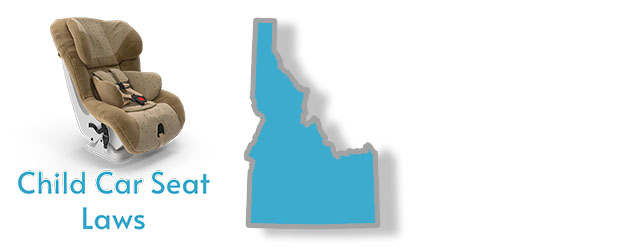A Summary of Child Car Seat Laws in Idaho

- Children under the age of 2 years should ride on rear-facing seats unless they exceed the manufacturer’s height and weight limits.
- Forward-facing seats can be used by children until they weigh 40-65 pounds and are at least 4 years old.
- A requirement for a booster seat is at least the age of 4 to 8 years old or height of 4’9”.
- A child can legally sit in the front when 7 years or older as long as he or she is wearing a seat belt.
Rear-facing Car Seat Laws in Idaho
The Idaho Department of Transportation requires children under the age of 2 years to ride on a rear-facing seat unless they exceed the manufacturer’s height and weight limits. Currently, most rear-facing seats support children of up to 40 pounds so your child may remain in this seat even up to 4 years of age if they haven’t exceeded the weight limit. This is safe for infants since the rear-facing seats are designed to absorb the impact of crashes to protect the baby’s fragile neck and spine. The seat should be secured in the back seat and away from an airbag since they are designed to protect adults, and maybe lethal to infants if deployed.
Forward Facing Car Seat Laws in Idaho
Idaho law does not state the requirements needed for children to ride on a forward-facing seat. However, the Idaho Department of Transportation recommends children should ride in a forward-facing seat until they weigh 40-65 pounds and are at least 4 years old. The department recommends the top tether to be used until the child weighs 40 pounds. Also, a child can graduate to the next seat if he or she has exceeded the seat’s upper weight and height limits. The seat should be fastened in the back seat and be turned around to face forward (applies to convertible seats).
Booster Seat Regulations in Idaho
The Idaho Transportation Department recommends children should ride in a booster seat from at least the age of 4 to 8 years or until they reach a height of 4’9”. Parents can use a backless or a high back belt-positioning booster, but lap belt only seating positions should not be used with booster seats. Booster seats raise your child so that regular seat belts can properly fit over your child’s thigh and chest areas. If your child has outgrown the forward-facing car seat requirements and can use seat belts without unbuckling them, then he or she can graduate to a booster seat. This type of seat should be federally approved and secured in the back. In the absence of a back seat, you can place the booster in the front seat (though not recommended) as long as there is no active airbag in the front passenger seat.
Requirements for children to use the front seat in Idaho
Idaho car seat law states children under 7 years of age are required to ride on a proper child restraint system that meets the federal motor vehicle safety standard. This means your child can legally sit in the front when 7 years or older as long as he or she is wearing a seat belt. To be eligible for a seat belt, the Idaho Transportation Department recommends children should be at least 8 years and have a height of 4’9’’. This is because car seat belts are designed with the average height of an adult in mind, so it’s important that your child’s body has the right height for a proper fit. The lap belt should snugly fit by lying low across the upper thighs and the shoulder belt should firmly lie across the chest area. Also, the child’s knees should bend at the edge of the seat.
Car Seat Law Exemptions in Idaho
Commercial vehicles such as taxis are exempt from complying with Idaho car seat laws when transporting a child. In the instance where all car seat belts are occupied by other children, the law allows a child to ride in the rear seat even if he or she is not restrained. Your child may also be exempted if you remove him or her from a restraint seat to take care of immediate bodily needs. You must hold your child when a child restraint system is not being used. Motor vehicles manufactured without seat belts before January 1, 1966, are exempted from complying with Idaho car seat laws.